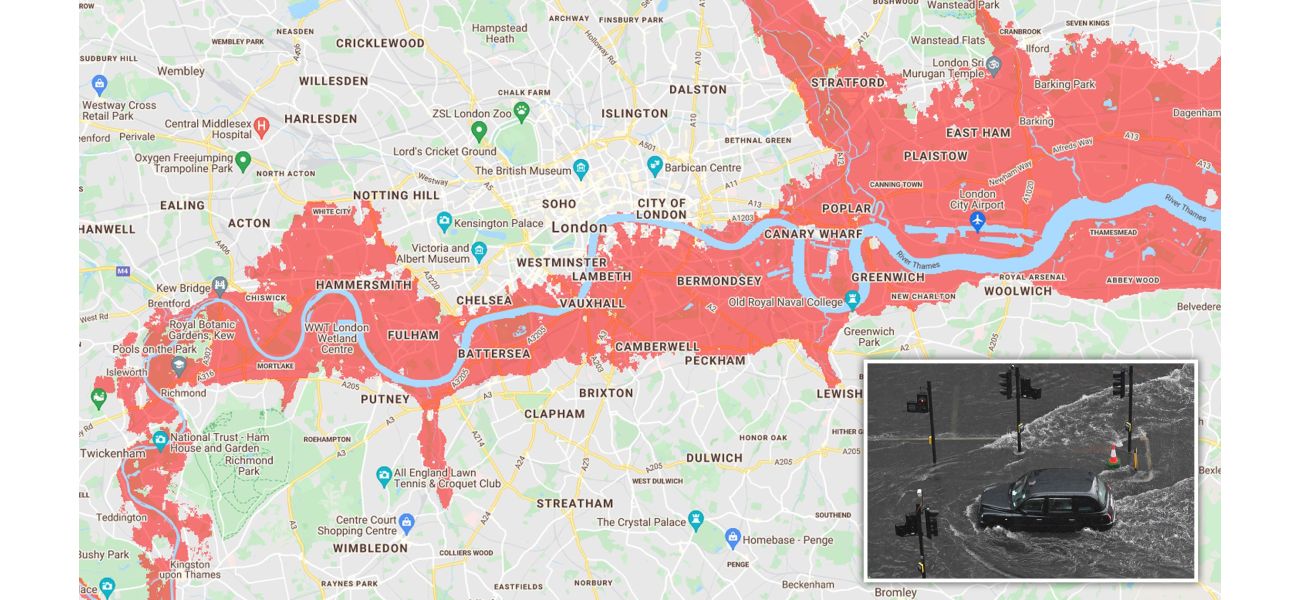What if London received Valencia's amount of rain this week?
Map displays flood-prone zones in the city.
November 1st 2024.

As Spain grapples with its worst flooding disaster in recent times, many European nations are contemplating the possibility of facing a similar fate. Climate experts have long warned about the increasing frequency of extreme weather events due to climate change and have urged governments to prepare for such crises. With London being home to almost nine million people and serving as the economic hub of the UK, the question arises - how would the city cope if it were to experience a day's worth of rain in just 24 hours, as was the case in Valencia?
While it's difficult to predict the exact impact, experts have previously stated that London is not equipped to handle such a deluge and could face catastrophic consequences. In fact, a recent study commissioned by London Mayor Sadiq Khan highlighted the city's inadequate preparation for severe flooding and extreme heat. The report, called the London Climate Resilience Review, warned of a "lethal risk" to vulnerable communities due to the lack of planning. Adding to the concern, a map released by non-profit organization Climate Central in 2021 revealed which areas of London are most at risk of flooding and could be regularly underwater by 2030.
The map, which allows users to explore coastal flood risk and projections for sea level rise, marks areas vulnerable to flooding in red. These areas are not protected by dikes and are likely to be below water level by 2030. Unfortunately, the outlook for London is bleak as many parts of the city, including West London and South London, are marked in red on the map. These areas include popular locations like Chiswick, Hammersmith, Fulham, Kew, and Camberwell. Even East London, including Greenwich, Stratford, Rotherhithe, and East Ham, could face the same fate.
The situation is further exacerbated by the fact that a lot of land in London, especially in the east and west, is low-lying and flat, making it more susceptible to flooding. In addition, the data used to create the map is based on a scenario of moderate cuts to pollution, meaning that if pollution continues to go unchecked, even more areas could be at risk. The London Climate Resilience Review report identified rising sea levels, surface water flooding, heat, drought, and wildfires as the main climate risks facing the city.
Review chairwoman Emma Howard Boyd stressed the need for a step change in the city's approach to climate adaptation, stating that Londoners now face "lethal risks." She highlighted the record-breaking temperatures and extreme weather events that have occurred in recent years, including the flash floods in 2021 and a heatwave in 2022. In response, London Mayor Sadiq Khan has proposed an additional £3 million in the budget to accelerate climate adaptation work.
As the city grapples with the realities of climate change, it's important for Londoners to voice their opinions and concerns. Share your views in the comments below and stay updated with the latest news from the capital by visiting The Agency's London news hub.
While it's difficult to predict the exact impact, experts have previously stated that London is not equipped to handle such a deluge and could face catastrophic consequences. In fact, a recent study commissioned by London Mayor Sadiq Khan highlighted the city's inadequate preparation for severe flooding and extreme heat. The report, called the London Climate Resilience Review, warned of a "lethal risk" to vulnerable communities due to the lack of planning. Adding to the concern, a map released by non-profit organization Climate Central in 2021 revealed which areas of London are most at risk of flooding and could be regularly underwater by 2030.
The map, which allows users to explore coastal flood risk and projections for sea level rise, marks areas vulnerable to flooding in red. These areas are not protected by dikes and are likely to be below water level by 2030. Unfortunately, the outlook for London is bleak as many parts of the city, including West London and South London, are marked in red on the map. These areas include popular locations like Chiswick, Hammersmith, Fulham, Kew, and Camberwell. Even East London, including Greenwich, Stratford, Rotherhithe, and East Ham, could face the same fate.
The situation is further exacerbated by the fact that a lot of land in London, especially in the east and west, is low-lying and flat, making it more susceptible to flooding. In addition, the data used to create the map is based on a scenario of moderate cuts to pollution, meaning that if pollution continues to go unchecked, even more areas could be at risk. The London Climate Resilience Review report identified rising sea levels, surface water flooding, heat, drought, and wildfires as the main climate risks facing the city.
Review chairwoman Emma Howard Boyd stressed the need for a step change in the city's approach to climate adaptation, stating that Londoners now face "lethal risks." She highlighted the record-breaking temperatures and extreme weather events that have occurred in recent years, including the flash floods in 2021 and a heatwave in 2022. In response, London Mayor Sadiq Khan has proposed an additional £3 million in the budget to accelerate climate adaptation work.
As the city grapples with the realities of climate change, it's important for Londoners to voice their opinions and concerns. Share your views in the comments below and stay updated with the latest news from the capital by visiting The Agency's London news hub.
[This article has been trending online recently and has been generated with AI. Your feed is customized.]
[Generative AI is experimental.]
0
0
Submit Comment





